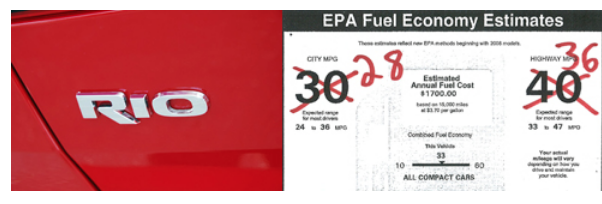
For three model years, Hyundai and its sister company, Kia, have advertised inflated fuel-economy numbers for many of their U.S.-sold vehicles. Admitting their guilt, Hyundai Motor America and Kia Motors America just announced that they will reimburse owners of these vehicles. The reimbursement program affects approximately 900,000 2011-13 model-year vehicles sold through October 31, 2012.
Remembering The Hyundai/Kia Mileage Scandal
Affected customers will receive a personalized debit card that will reimburse them for their difference in the EPA combined fuel- economy rating, based on the fuel price in their area and their own actual miles driven. “In addition,” Hyundai announced, “as an acknowledgement of the inconvenience this may cause, we will add an extra 15 percent to the reimbursement amount.”
Hyundai and Kia came to this decision after an investigation and audit by the U.S. Environmental Protection Agency (EPA). The EPA had investigated Hyundai/Kia’s mileage numbers after a group called Consumer Watchdog complained that their 40-mpg claims were inflated. According to Hyundai, “Procedural errors at the automakers’ joint testing operations in Korea led to incorrect fuel economy ratings for select vehicle lines.”
The size of the reimbursement checks will not be huge. Hyundai and Kia are stating fuel-economy discrepancies (combined city/highway) of only 1 to 4 mpg (mostly 1 or 2) for affected vehicles. As an example, the owner of a 2012 Elantra (automatic), who thought he or she was getting a 33-mpg car but actually bought one that averaged only 32 mpg (according to Hyundai’s new numbers), will be reimbursed for that 1-mpg difference. If the person has driven 12,000 miles at $3.75 per gallon, he or she would be reimbursed about $50—which includes the 15-percent “acknowledgement of the inconvenience” fee.
Volkswagen Sucker-Punches the Media and Brand Loyalists, Becomes Hyundai
The reimbursements likely will cost the South Korean automakers tens of millions of dollars. Still, it’s a drop in the bucket for Hyundai, which made a $2 billion net profit in the third quarter of 2012 alone. Hyundai’s net profit in 2011 was $7.2 billion—and Kia’s $3.1 billion—in part, we presume, because of their advertised fuel-economy numbers.
Among all 2012 mass-produced vehicles sold in the U.S., we counted 31 with claims of 40 mpg. Of those, 27 had a “catch”; they were a hybrid, an electric vehicle, or required the purchase of a fuel-economy package to get to 40 mpg. Only four got 40 mpg “naturally”—and all were from the South Korean automakers: the Hyundai Accent, Hyundai Elantra, Hyundai Veloster (manual), and Kia Rio. As it turns out, there was a catch; they weren’t actually 40-mpg vehicles. Now the automakers are saying that the highway numbers for those four 2012 vehicles are: Accent, 37; Elantra, 38; Veloster (manual) 37; and Rio, 37 manual and 36 automatic.
At Consumer Guide, we have frequently pointed out significant discrepancies between listed and real-world fuel-economy numbers on certain Hyundais and Kias. For example:
• In over 8,500 miles of driving on our 2012 Accent (automatic) extended-use test vehicle, we are averaging 29.0 mpg. That’s 4 mpg below Hyundai’s original claim of 33 mpg in combined city/highway driving (and 2 mpg under the new claim of 31 mpg).
• Kia’s numbers on the 2012 Rio sedan (automatic) were 30 city, 40 highway, 33 combined. Over 498 miles, we averaged just 25.7 mpg with a slight city bias.
Fuel-economy numbers come from the automakers themselves and are based on a rigid set of procedures under controlled conditions. The EPA selectively performs subsequent audit testing.
For the original and revised Hyundai and Kia fuel-economy numbers, click the links below:



